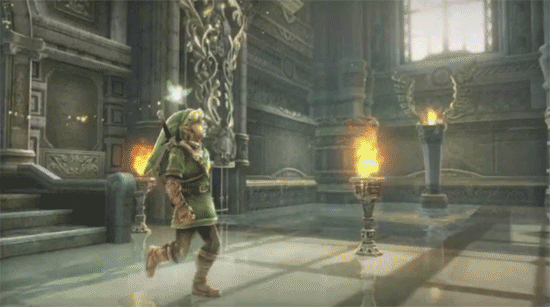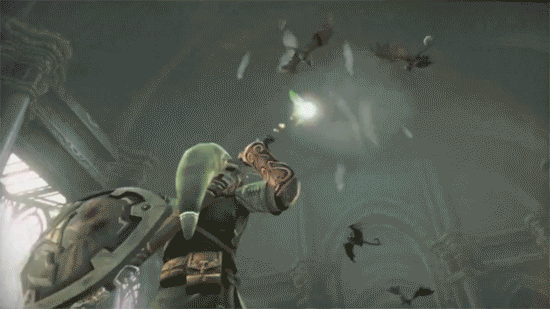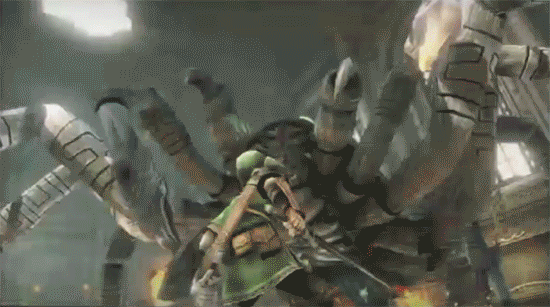ATI Discusses GameCube Graphics (Part 2)
Wrapping up our discussion we cover Flipper's texturing abilities, the new-look Zelda, and more.
October 31, 2001
by IGN Staff
In the final part of our ATI interview, Greg Buchner discusss Flipper's texturing abilities, the alteration of the clock speed, and expands on just how hard it is to turn the Legend of Zelda into a cartoon. Mr. Buchner also comments on the future of ATI and Nintendo®, hinting towards a future partnership. Read all about it in this in-depth interview.
IGNcube: Can you talk a little bit about the texture processing power? We know you have your secrets, but for instance on the GameCube spec sheet you list eight simultaneous textures as a feature. Can you explain how that works?
Greg Buchner: The magic, I would say, is not in the fact that there are eight of them, but how the eight go together. How the eight can interact with each other, how one texture can modify another texture, or how you blend them together -- so that's the real magic. That fact that you can do one texture and then do a second, well whoop-de-doo. And a third one, or even twenty of them that's really just silicon. How you put them together and the intelligence of putting them together, and how you expose that in an API so developers can properly control it, that's really the magic.
IGNcube: These eight simultaneous textures, how much does it hurt performance to utilize them as you move up in numbers?
Greg Buchner: Look at the applications.
IGNcube: Such as Rogue Squadron II? Yea, we can see that's doing a lot. Any specifics you can talk about?
Greg Buchner: I won't give out any numbers. I'll let Nintendo® do that.
IGNcube: When the clock speed changed around last year's E3 you said it was to balance the system out. We were surprised to see you took back the speed of the graphics chip because it is so powerful. What would you say is the difference in power between the former 200 MHz chip and now the 162 MHz chip balanced with this newer, more powerful CPU?
Greg Buchner: Going back to an application point of view, having more of a balance between the two is going to make the game better at the end of the day. Having one piece of the system have much, much more performance than another, well maybe from a benchmark or contrived case point of view you might get something for it, but if you have one weak link in a chain, you still have a weak link. I'm not saying that the CPU was a weak link before, but having more balance there made a lot of sense. And due to some ratio issues there, the ratio leads to having these kinds of fixed multiples. We wanted to get more CPU [power] and to get that number we couldn't find the right multiple there, so we had to actually drop [Flipper's speed] to make them line up.
IGNcube: Why is it set to such certain multiples?
Greg Buchner: It's integer multiples of each other. You've got a 3:1 ratio.
IGNcube: Is that because of the whole architecture of the system that you can't do any other multiple variations?
Greg Buchner: It's a very common thing for a CPU interface. So if you look at the PC world it's the same thing, you've got the front-side bus that has, you know, a certain clock rate and there's multiples of that to the CPU. Right now it's kind of in 50 MHz multiples on the Intel side. They had some busses that were 33 MHz or 66 MHz intervals. So you saw these weird steppings, like you saw a processor that was a 733 MHz and then when they went to Pentium III it was suddenly 500, 550, 600, etc. So there are these ratios, and basically what's happening is you're trying to have a bus that's synchronous between two devices and you need to run at a fixed multiple. If you made them asynchronous, then what you introduce is latency. If we had started day one and said we wanted to have a different set of multiples, we probably could have worked with IBM and we might of come up with something different that had finer grain multiples. But as developers got their hands on the system, seeing what they could do with it, we though, you know, here's a nice change to make. At that time, with what was in our toolbox that was a choice we could make.
IGNcube: In the future will any of Flipper's technology be integrated into ATI chips?
Greg Buchner: The team that worked on Flipper has been working on products in the PC space for quite some time now. What you saw at [last year's Space World] was basically the "final silicon," so that team's been off for over a year now doing something in the PC space. So, yes you'll start seeing technologies, ideas, but you're not going to see an exact piece of that chip coming out and being used in the PC space. PC APIs are different, the requirements are different. A lot of the concepts, a lot of the things we created are ATI property, ATI owns the ideas and we're going to exploit those in other areas. So, stay tuned there.
IGNcube: The CPU interface we've heard a lot about. At the recent Embedded Processor Forum they had a shot of Luigi's lit face from Luigi's Mansion when they were talking about the CPU. Saying that the CPU was used for the really up-close lighting. Could you describe the relationship between the CPU and graphics chip and how important it is they work together?
Greg Buchner: What we've done in Flipper is optimize things that are happening a lot. Things that are common to do in a game, common to do in an application that really need to make high-performance you move those into dedicated silicon. You're basically running a program in the dedicated silicon. Things that you occasionally need to do you may not want to go and dedicate a lot of gates to them which adds to the cost, so you want to have a very good general purpose CPU that can run an algorithm. You might have some really cool special effect in lighting for example, that you may not have dedicated gates for but you've got now this powerful CPU. So you go do, those set of triangles you might do some lighting algorithm on there so that might have been what was referred to [at the Emedded Processor Forum].
IGNcube: How directly is the Gekko CPU and Flipper graphics chip linked?
Greg Buchner: Looking at a block diagram, Flipper is the center of the universe. Everything else connects to Flipper. So the CPU plugs directly into Flipper, main memory plugs directly into Flipper, controllers plug into Flipper, flash cards plug into Flipper, the expansion slots for the modem or broadband adapter plug right into Flipper, the digital video out plugs right into Flipper. The only thing that doesn't plug into Flipper is a set of DACs (digital analog converters) for the TV out and the audio. So that communication between Flipper and Gekko is very important.
That's one of the areas where we went in and made some changes to the standard PowerPC bus to improve the performance. It's till very much in the spirit of the standard PowerPC bus, but we added some enhancements. You get in some cases much higher bandwidth than you could normally get. Usually you can take the clock rate times the number of bytes, and that's your not-to-exceed number. Rarely does anything allow you to get that number. What we've done is made it so that in some cases we can get very, very close to peak. What you typically get is within 50-75% of peak for nice data patterns.
IGNcube: So when you say "peak" on the spec sheet, you're getting pretty close to it?
Greg Buchner: In certain cases. There's a pattern you can get which gets you very close to peak. There's another set of things that you're not going to get to peak just because of the way that the protocol is set up. But it's still better than the other two guys that are out there. It's still a very good bus.
IGNcube: How close did you work with IBM and when did that relationship start happening?
Greg Buchner: In the summer of '98 we had what we call the Beauty Contest to look at the processors that are out there that we'd want to use as the basis for GameCube. We looked at a lot of different choices and went through a lot of different things and made many comparisons. And by combinations of raw performance we chose what would be a good basis for building the system. We knew we weren't going to find something that was perfect for what we wanted, so we figured we needed a team that we could trust to go do some changes, could deliver on a schedule, and also deliver on a cost point.
We narrowed it down to a couple of choices fairly quickly, did a lot of detailed analysis and in the end this was the right choice. Then the business relationship had to work out between IBM and Nintendo® at that point. Once that settled then we said, okay, it's a good baseline and part of the business discussion was that IBM was going to have to make some changes. Even though they thought it was a good general purpose CPU, and it is, there's some things that it's missing to do good gaming. So we had them add those things. That was a very close relationship between all three parties, because Howard Cheng was specifying some of the changes, we were specifying some of the changes, working through the changes, and certainly all the bus changes had to be very tightly coupled. So there were daily phone calls for quite a while, frequent meetings, and things like that. It was a good relationship, and we ended up hiring one of the guys from IBM's teams.
IGNcube: The new cartoon look of Zelda is amazing. We saw the cel-shading demonstration at last year's Space World, but it was a relatively quick demonstration. It was great to see that it could be used so easily, but Zelda is so far beyond that. Maybe you could describe what's going on there? We think a lot of people underestimate the technology. From a technological standpoint what would you say it's doing?
Greg Buchner: [Jokingly] Well if it wasn't such a big deal, people would have done it a long time ago. It's not easy. It took a lot of work. There's some extra stuff we did in order to enable that. There's some things we put in the camp of inventions and there's some patents that have been applied for in that area. It's not an easy thing to do, and even though in the end, oh gee, you're creating sort of a 2D surface instead of 3D that should be easier, but it's not. Finding the contours, finding where the edges go is a very difficult problem.
IGNcube: Would you say that the other two players on the marketplace could do that kind of thing?
Greg Buchner: If they didn't focus on it, I... Well, it's not something that falls out for free. I don't know what either one of them has done, but haven't seen any evidence from either one of them so I'd say we're probably unique in that regard.
IGNcube: Do you have any favorite games, speaking from a technical standpoint? You know what Flipper can do, do you see any that are pushing it a lot faster than you thought it could be pushed?
Greg Buchner: Tough question because I don't want to single out anyone. Um, I guess overall there's been a couple things that I've seen where you kind of get that chill down your spine and say, this is some really great stuff, impressive stuff. Even knowing the horsepower of what we've provided the developers, just seeing what they've done. The impressive stuff to me, you know I'm going back a year, is where a developer rode away with a development strapped to the back of a motorcycle and five days later you're looking at one of these demos that were shown at Space World last year.
To me that was impressive, because that really showed off how easy this machine is to use. They got really high performance, like the Star Wars demo from last Space World. That was basically done in like five days. That stuff was just amazing. But I think the machine hasn't been fully tapped, it's going to be a while before people do tap into it. There's a lot of focus to getting the first games out, you know the initial launch titles. I think in the second year they'll really get a chance to dig into the machine and start figuring out some things. You know, dig a little deeper in the toolbox and see what's there. I don't think we've seen all that's going to come out of this by any way, shape, or form.
IGNcube: Do you think that because it's proving to be such an easy thing to program for that we'll see the difference in generations? With the N64 you had specific first, second, and third generation titles. You could pick them apart. You could look at a game and see that. Do you think we'll see that kind of separation on GameCube as well?
Greg Buchner: I think you'll see a different kind of separation. I think you'll still see one. On N64 it was difficult to program and so therefore the second year people figured out how to get a little more performance out of it. But here I think even though they are starting higher up the performance curve there's still a rich feature set that I don't know has been fully tapped because people haven't had all these tools in their toolbox before.
So there still developing things with now just high-performance taking some advantage of some of the multi-texture capabilities, but I think a year from now you'll see newer ideas and newer things you can do. So I think you'll start seeing much more on the features side and less and less from the performance side. So you'll see this higher rate of polygon counts and fill rate, but in terms of what you do with that and what effects you get I think you're going to see a lot more. So it's a different level of changes over the years.
IGNcube: Where from here does it go for ATI and Nintendo®? We saw your logo on the GameCube, so you must have a great relationship with them. Do you think you'll be working together in the future?
Greg Buchner: I see no reason we won't be. I think from a company-to-company relationship it's a very good relationship and from a person-to-person level it's an excellent relationship. There are a lot of folks on both sides who I think consider themselves friends, not only working together, producing something, but people you can call at home and talk to. Also, we're there if they need anything, they know they can call on us to go do something. You know, we'd move heaven and earth right now to help them with something. So I think it's been a good partnership. A lot of the people have had a good relationship for two generations. A year ago we started talking to factory people, well the same person working with the factory people for the N64 [was helping for GameCube].
You know the same two people show up in a room together, and they already know each other so they've already been through one war. It's easy to start off and hit the ground running. I think we've got the best shot of anybody out there to continue working with them. I see no signs of them backing away from us or vice versa. These are fun products to do, so from a pure engineering point of view this is cool sh**. There's not another thing like this in the world and even if you look at the other consoles, the way the companies are and the way they build consoles is very, very different from the way Nintendo® approaches it. Nintendo® doesn't view themselves as technologists, so they bring in the best technology partners they can to go produce something and they give you the ability to really create almost anything from a clean sheet of paper. To go build the best possible thing you can for where they're focused. And there is a lot of fun to that. So I'm going to do whatever I can to make sure we're in there.
IGNcube: We would definitely like to see that happen.
IGN would like to thank Greg Buchner of ATI for taking time out of his busy schedule to chat with us.
Interview conducted by Fran Mirabella III








